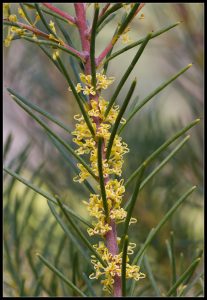This image by Bill Higham, has licence: CC BY-NC-ND 2.0 <https://creativecommons.org/licenses/by-nd-nc/2.0/jp/>
| Botanical Name: | Hakea nodosa |
| Common Name: | yellow hakea, yellow needlebush |
| Sold As: | Tube ($2.00) |
| Plant Type(s): | Tall Shrub (2 to 6 m), Bird Attracting |
| Growing Conditions: | Full Sun, Partial Shade
Moist, Wet, Boggy, Poorly Drained |
| Size (HxW): | 1-3 m x 1-2 m |
| Foliage: | Blue-green soft needle-like foliage, pointed but not as sharp as other local hakea species, 0.8-5 cm x 0.7-2.5 mm. |
| Flowers: | Yellow flowers April to August. Small clusters of flowers in leaf axils, massed up the branches. Fruit - prominent, oval to round, warty, to 3 cm, lacking horns. |
| General Comments: | It usually grows reliably and in full sun to part shade with some reliable moisture. It is reported to be a useful and fast growing screen plant and will tolerate wet conditions better than many other hakeas. It will adapt to quite dry positions. It grows in swampy areas on sandy soil as part of swamp shrublands and swamp sclerophyll woodlands, as well as wetter heathlands. Moist to wet clay soils in heathy woodlands and around swamps. Frost tolerant. Full sun to full shade. Remarkable for producing 2 fruit types, one with a smooth surface, not developing any marked woodiness and opening while still attached to the bush, the other woody and usually with a rough tuberculate surface, which remains closed while attached to the bush. Woody fruits in Victoria are usually less than 2.5 cm long and 1–1.5 cm wide. |
 Further Information: | |
| Plant Propagation: | From cuttings or seeds. |

